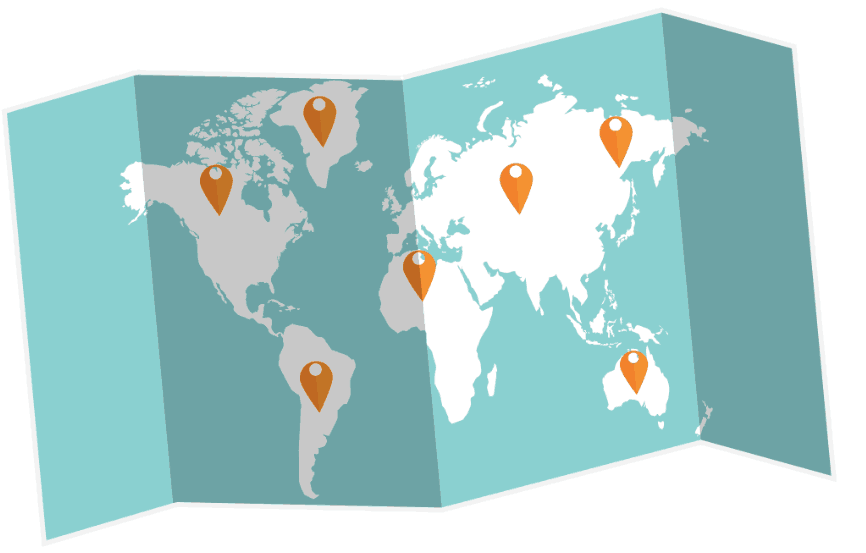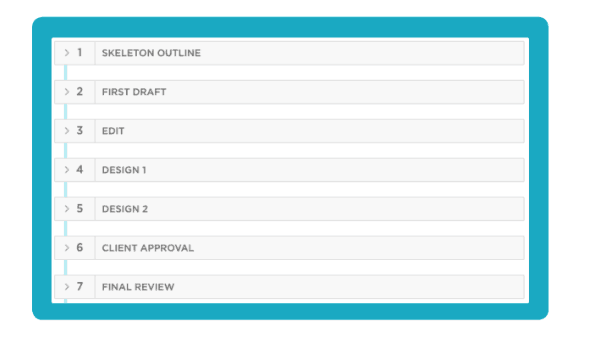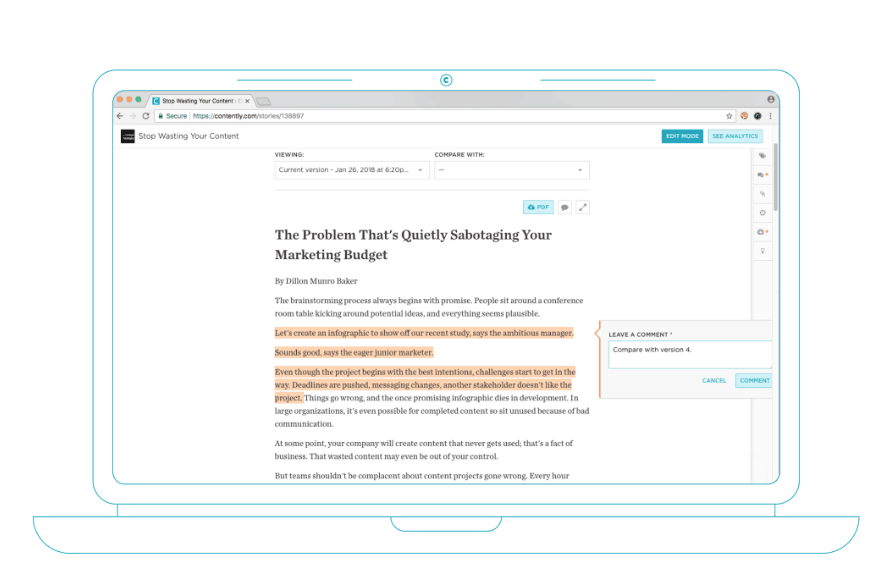Strategy
Content Scale & Alignment: 7 Steps for Building a Better Content Program
This is an excerpt from The Content Marketer’s Playbook: Grow Your Content Program. Click here to read the entire e-book.
Brands are creating more content than ever before. According to CMI’s 2019 benchmark report, a majority of both B2B and B2C marketers increased content creation budgets from 2018. Roughly two-thirds of marketers created more written, audio, and visual content year over year.
However, despite bigger budgets and outputs, content teams remain relatively small. In 2018, Forrester reported that “most in-house creative teams are small; 54% of those teams have between one and 10 people. So being able to scale content with limited resources is key.”
Content marketing is still a fairly new practice, but brands don’t have to settle for limited resources. As companies mature, they’re finding ways to show the value of content and use that evidence to grow accordingly. They’re balancing quality and quantity, and you can too by following these steps.
Review your existing content strategy
In 2019, most people understand the importance of a content strategy (even if only a little more than half have one.) What’s not as obvious is how they should adjust their plan when scaling.
A content strategy is a living document. Like any plan, it needs to evolve. Just think about how much marketing has changed over the last few years. If you’re trying to scale, that’s a great time to take a step back and review your strategy.
Now, you don’t have to reassess everything. Your company mission usually doesn’t fluctuate. But other aspects of your strategy need to be reevaluated, especially if new teams are going to create content from scratch. Think of it this way: RBC’s personal and commercial banking division will care about different topics than the insurance division.
Specifically to scale, you’ll definitely need to assess a few parts: new goals and KPIs (more on this in a few pages), SEO keywords, and an updated gap analysis. How you’ll refresh those parts depends on which way you’re trying to scale.

Let’s use setting goals and KPIs for now. If you’re expanding to an international LOB, your new goal could be to build a loyal audience in the UK. A good KPI for that might be reaching 10,000 returning visitors to your content after a year. Those are standard brand awareness goals.
However, if you’re growing to a different part of the funnel, your goal could be to start a lead generation program with a KPI of generating 1,000 marketing qualified leads.
(We covered building a content strategy in the first playbook, so consult that to review all the steps.)
Don’t be afraid to use the review period as a chance to make a big adjustment. You have to test assumptions that get taken for granted. An approach or tone that makes sense in the United States may not work as well in another part of the world.
In the first playbook, we revealed how athenahealth recently reset the voice and tone of its content, even after years of successful thought leadership. Working with the help of an agency, the content team made the tough choice to try a different course of action in the hopes of growing its audience.
“We did a whole reboot on our brand voice,” said John Fox, executive director of content. “That was an evolution for us. In previous years we’ve had campaigns that are very focused on the pain, and we’re now pointing the way out of the pain and pointing toward a bright future for healthcare.”
Get key stakeholders on board
Scaling requires you to make the case for content marketing all over again. Even if creating more content and collaborating with other teams makes sense to you, that won’t mean much if executives don’t see the value.
It’s your job to show them the value, communicating why content can make a difference for your companies. Margaret Magnarelli, executive director of growth marketing at Morgan Stanley, took a reporter’s approach in her last role at Monster.com to get people aligned. “I interviewed all the people who would be stakeholders in our work,” she told us. “I said, ‘What do you want to get out of what we do?’ Just like that, people told me what they did and their understanding of [content].”
Having served as the executive editor at Money Magazine, Magnarelli’s journalism experience gave her an advantage. But you don’t need to be a seasoned reporter to get executive support. You just have to learn what makes them tick, and the easiest way to do that is to ask them questions that make them feel heard. Find out what they think of your brand messaging, see if a particular piece of content resonated with them, and dig into any problems keeping them up at night.
The common mistake people make here is assuming that stakeholders view content marketing the same way they do. Editors and strategists tend to focus their attention on quality, productivity, and audience building, while executives prioritize control and tying content to revenue. When you’re asking for more resources, find common ground.
If scaling is the goal, consider efficiency from an exec’s perspective. Manulife, a former Contently client, wanted to institute a better process for sharing content and repurposing assets. The insurance company developed a system that tracked savings, and over a six-month span, it avoided $1.2 million in content costs. That data point illustrated the clear value of content to everyone.
Set new goals and objectives
When first documenting a strategy, your initial goals are more like educated guesses. After a year, though, you should have real benchmarks to analyze. Forecasting growth will never be an exact science, but any time you’re increasing content production with the same team or creating content with a new team, your goals should change. And you’ll be in prime position to pull the right levers.
In 2017, Joe Lazauskas, Contently’s head of marketing, elaborated on the importance of collecting good data:
Block quote: Raw data that you have about your audience—think audience demographics, persona research, and first-and-third party data about what content they like to consume or tends to drive sales—should translate to insights. For a finance brand, this might result in something like: “High-income millennials in the northeast are more likely to watch financial advice videos on Facebook than any other network, and engage disproportionately with content that triggers nostalgia.”
Let these trends influence your latest goals. Last year, for instance, we cut back on media stories when we saw their average performance had slipped, but we set a new goal to launch a pilot video series because our audience told us they were interested in more multimedia. The five-part series brought in close to 10,000 views on YouTube plus thousands more with social clips. That engagement sparked discussion for a bigger video budget. And in 2019, we’re hiring a video producer to help us reach our new goal for the second half of the year: creating one video per week.
As you scale, the number of stories you publish will jump up. That archive sets off a snowball effect. Over time, content that supports longtail keywords should lead to a steady increase in the size of your audience, and your goals should reflect that. Redpoint venture capitalist Tomasz Tunguz referred to this as “the compounding returns of content marketing.”
Update your workflow
Bolstering your content program is an opportunity to explore new areas. If you used to publish one article per week, now you can try two. If you only produced blog posts before, maybe scaling means starting to create visual content like infographics and video.
You’ll also have to adjust your workflow to incorporate news teams and stakeholders. When we’re producing a top-funnel infographic for The Content Strategist, our workflow includes two rounds for copy, two rounds for design, and one final approval step. But when we’re creating a mid-funnel case study that involves a client, we broaden the workflow to include three rounds for copy, two rounds for design, one round for client approval, and one final step for internal approval.

Some projects call for more steps than others, but the point is you’ll need to customize workflows as you scale. When athenahealth committed to producing more visuals to show off its original research, the content team baked more time into the workflow for design. “Infographics are much more time-consuming and take more rounds of design and iteration,” Fox said. “That influences how many we’re able to produce.”
Fox’s team consists of three full-time writers and editors, plus freelance contributors. For visual content, though, they rely on information designers who have other responsibilities within the company. So they spend some of their time helping on the infographics for athenaInsight, the company’s digital publication, but they also work on projects for the rest of the marketing team. Since Fox only gets a portion of the designers’ time, he had to be realistic about what his team could create without full-time resources. The solution was to build out a longer workflow for visual assets. The team still runs three posts per week with a standard workflow, but they periodically add in visual content to give the site an engaging wrinkle.
Simplify communication across the organization
If you’ve ever played a game of telephone, you know what happens to a simple message when dozens of people get involved. When scaling a content program, you have to be vigilant about consistency and efficiency, otherwise, your creative efforts will get lost or sidetracked in endless email threads.
People work differently, but there are ways to minimize the confusion throughout the company. We recommend investing in a product that brings all stakeholders and practitioners together. Doing so will free up time and money that can be better spent producing content. At Contently, we use our own platform to manage pitches, share assets, create content, and analyze results. We also chat on Slack for quicker conversations about news, trends, and updates.

These platforms will cost money, but they shouldn’t break your budget. The commenting feature is one part of Contently’s larger offering. Aside from Slack, other popular tools in this space include Asana, Trello, and Wrike. Regardless of which one you choose, ensure that everyone is on it and knows how to communicate. Marketing stacks can get messy, so limit the tools in your arsenal to strengthen brand governance.
Consolidate your review process
Lawyers are like referees—the less you notice them, the better. Content creators may not enjoy legal review, but it’s still a necessary piece of the puzzle for most brands. We’ve heard too many horror stories about 800-word blog posts that get stuck in purgatory for three months. This headache is one of the biggest obstacles to scaling your content program.
Getting around that obstacle calls for creative thinking. RBC devised a simplified review process that only needed a single member of the legal team to review all content. The legal and marketing teams joined forces to outline a system that helped eliminate hours of gridlock for each individual piece of content. They created a document full of key “watch-outs” and best practices that the content creators could reference regardless of the subject matter, thus making life easier on the person reviewing.
“Each group that we work with has a customized workflow,” Paxton said. “However, when we initially launched, we centralized the legal review. Because we weren’t going too deep into product information, we thought it would be much simpler.”
Streamlining the process can also work if you’re pushing timely content out into the news cycle. Tangerine, a digital bank based in Canada, covers breaking financial news a few times per year, so the content team found a way to reduce the red tape for those unique situations. If there’s an interest rate announcement by the government, the team can create a new story or update an old one the same day.
“There are certain rules that we’ve worked on with legal,” said Darin Diehl, Tangerine’s director of content marketing and corporate communications. “When we know we’re going to need a fast turnaround from legal, we give them a heads up. It wouldn’t work if we had to do it every week, but we’re selective about it.”
The common thread between these two examples is clear communication upfront. If you can anticipate certain situations, the legal team will be better prepared to give you the greenlight before too much time passes.
Explore new distribution channels
Content distribution is a world split in two. There’s organic distro, the flashy side full of clever, funny, eye-catching posts going viral. Then there’s paid distribution, where the social platforms make their money charging publishers and brands to reach all of their users.
Scaling could give you new access to both sides. The upside of expanding to a new part of the organization is you now have the ability to sync with other channel marketing teams. Walmart’s top-funnel content team was able to place blog posts in different email marketing efforts as its program grew. This collaboration between teams distributed their content right to the screens of a huge new audience.
When content programs evolve, they could also tap into existing media budgets for paid distribution. Like casinos on steroids, social platforms rig the game in their favor. Organic social has submarined over the years on Facebook and other networks. Optimizing content for search combats some of the organic social losses, but one of the only ways to predictably build an audience is to pay. Smaller content teams don’t always have the resources to compete.
When it comes to paid social, quality still matters. You can’t just spend a bag of money and expect millions to click. The research on personas that went into your content strategy is essential here. The major platforms like Facebook and LinkedIn have developed advanced targeting features, so you can reach people based on factors like company, job titles, location, interests, and more.
Your best bet is to selectively invest in your top-performing pieces of content. They’ll likely land you the lowest cost-per-click and bring the most people onto your site. On The Content Strategist, we wait until a new article collects data for a week or two. If we notice a strong response, we put $100 behind it on Facebook while testing different headlines, images, and call-to-action copy to find the most effective combination before investing any more.
As Lazauskas wrote: “Acquiring new readers in your target audience is what allows a content marketing program to grow. Content only matters if people see it.”
This is an excerpt from The Content Marketer’s Playbook: Grow Your Content Program. Click here to read the entire e-book.
Get better at your job right now.
Read our monthly newsletter to master content marketing. It’s made for marketers, creators, and everyone in between.




